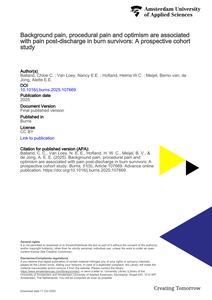Pain following burn injuries can be severe and may persist after hospital discharge. The experience of pain is influenced by multiple biological and psychosocial factors. Post-discharge pain may be related to pain experienced during hospitalization as well as anxiety associated with these pain experiences. There are also protective factors; one notable example is optimism. However, the role of optimism in burn-related pain has not yet been investigated. This study aimed to describe the extent of pain measured over 14 consecutive days post-discharge and to examine its relationship with background pain, procedural pain, pain-related anxiety, and optimism. This multi-center longitudinal cohort study was conducted in five burns centres. The results showed that 50 % of the patients had a pain score ≥ 2 on a 0 – 10 scale after discharge, which on average decreased further over the next 14 days. However, a subgroup of patients maintained elevated pain levels. Patients with higher pain scores post-discharge were more likely to have experienced higher levels of background pain and procedural pain in-hospital and they scored lower on optimism. Pain-related anxiety did not independently contribute to pain post-discharge. The results indicate that patients with high pain scores during hospital admission may need specific attention regarding pain management when they leave the hospital. Furthermore, patients may benefit from optimism-inducing interventions in the hospital and thereafter.
DOCUMENT

A growing interest in person-centered care from a biopsychosocial perspective has led to increased attention to structural screening. The aim of this study was to develop an easy-to-comprehend screening instrument using single items to identify a broad range of health-related problems in adult burn survivors. This study builds on earlier work regarding content generation. Focus groups and expert meetings with healthcare providers informed content refinement, resulting in the Aftercare Problem List (APL). The instrument consists of 43 items divided into nine health domains: scars, daily life functioning, scars treatment, body perceptions, stigmatization, intimacy, mental health, relationships, financial concerns, and a positive coping domain. The APL also includes a Distress Thermometer and a question inquiring about preference to discuss the results with a healthcare provider. Subsequently, the APL was completed by 102 outpatients. To test face validity, a linear regression analysis showed that problems in three health domains, i.e., scars, mental health, and body perceptions, were significantly related to higher distress. Qualitative results revealed that a minority found the items difficult which led to further adjustment of the wording and the addition of illustrations. In summation, this study subscribes to the validity of using single items to screen for burn-related problems.
DOCUMENT

Pain in critically ill adults with burns should be assessed using structured pain behavioural observation measures. This study tested the clinimetric qualities and usability of the behaviour pain scale (BPS) and the critical-care pain observation tool (CPOT) in this population. This prospective observational cohort study included 132 nurses who rated pain behaviour in 75 patients. The majority of nurses indicated that BPS and CPOT reflect background and procedural pain-specific features (63–72 and 87–80%, respectively). All BPS and CPOT items loaded on one latent variable (≥0.70), except for compliance ventilator and vocalisation for CPOT (0.69 and 0.64, respectively). Internal consistency also met the criterion of ≥0.70 in ventilated and non-ventilated patients for both scales, except for non-ventilated patients observed by BPS (0.67). Intraclass correlation coefficients (ICCs) of total scores were sufficient (≥0.70), but decreased when patients had facial burns. In general, the scales were fast to administer and easy to understand. Cut-off scores for BPS and CPOT were 4 and 1, respectively. In conclusion, both scales seem valid, reliable, and useful for the measurement of acute pain in ICU patients with burns, including patients with facial burns. Cut-off scores associated with BPS and CPOT for the burn population allow professionals to connect total scores to person-centred treatment protocols.
DOCUMENT
